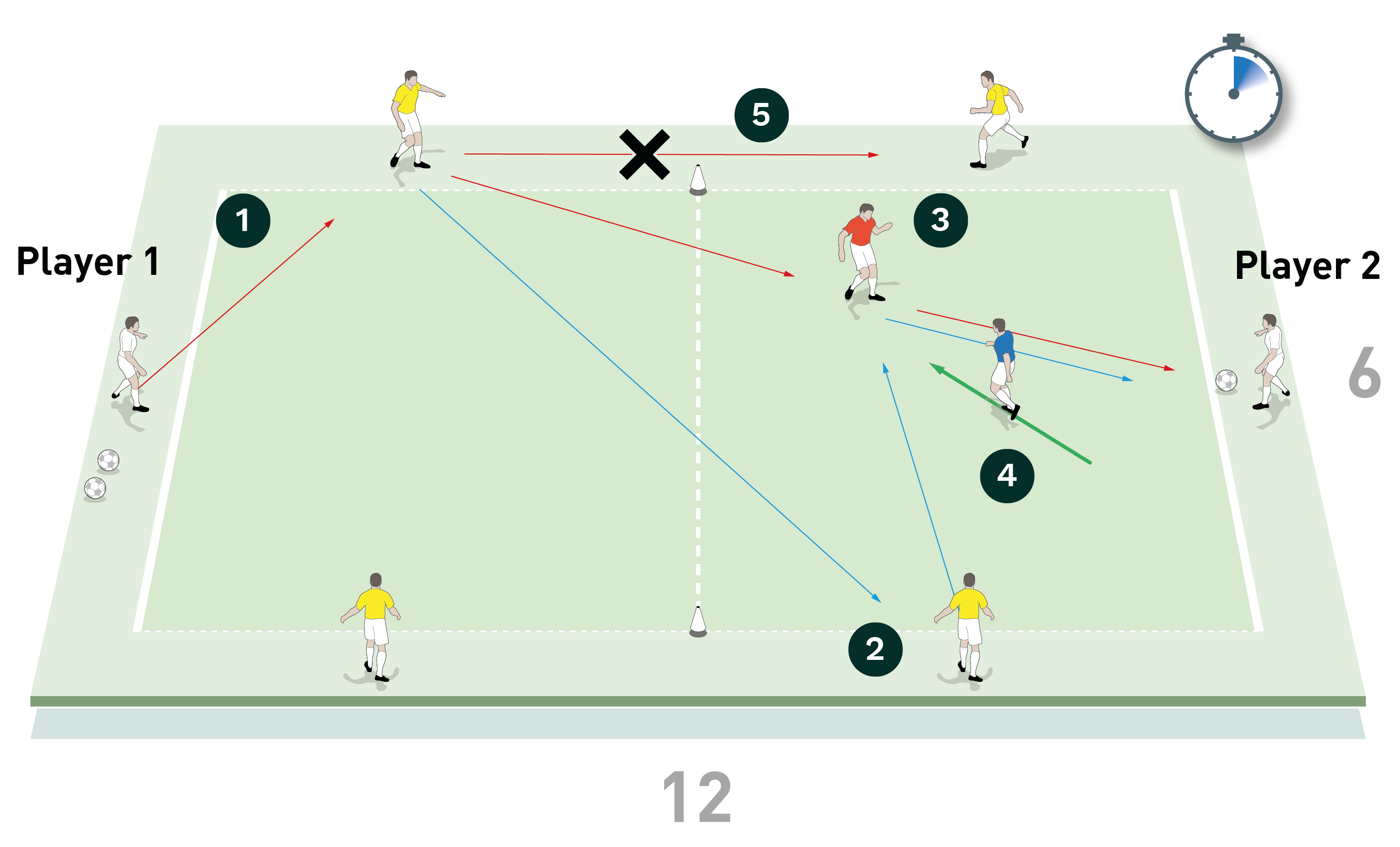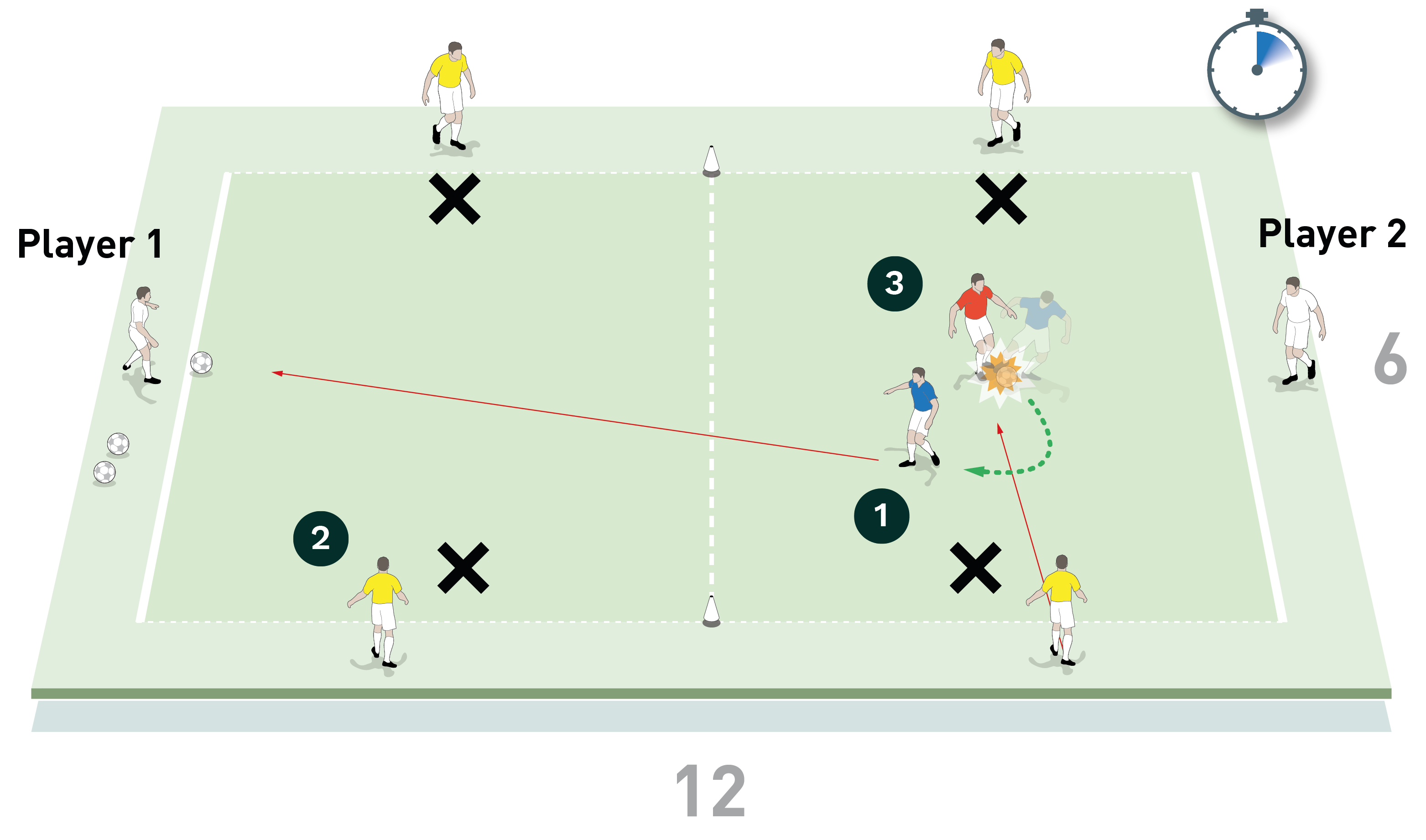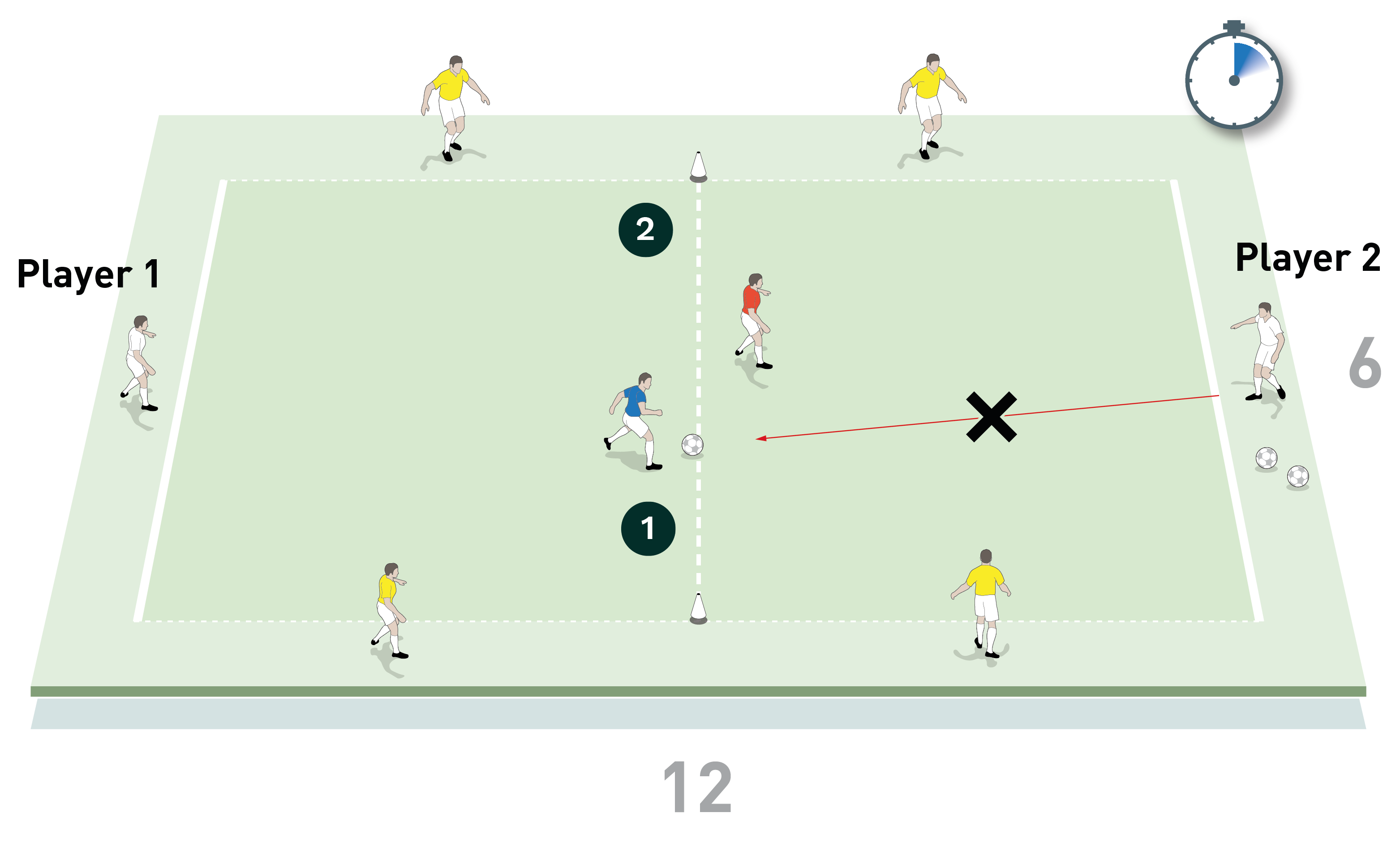You are viewing 1 of your 1 free articles
Rondo 2.0
| Area | 12x6 yards |
| Equipment | Balls, bibs, cones |
| No. of Players | 8 players |
| Session Time | Game-related rondo: 15mins |
This practice can be used to achieve various outcomes relating to passing and receiving. The primary outcome is to support players with their understanding of movement off-the-ball so they can engage opposition defenders in order to combine with others to play forwards.
It’s an activity that demands a high intensity performance. It encourages players to constantly find spaces that allow them to be used as a decoy, or as a combining player in a phase of play, so the team can progress the ball forwards as often as possible.
I consider this a more effective and game-related upgrade to a traditional rondo and it will challenge players across the four corners. It forces them to make effective decisions with their movement to support the team in penetrating the opposition, which is fundamental if we are to create more attacking phases of play and potentially more goal scoring opportunities.
I love using this practice because it can work with as few as five players, and with adjustments to area size it can be performed by as many as 16 players.
Because of the versatile nature of the activity, it can serve as an effective platform for various themes or topics. For that reason, it is a practice that I run in most sessions, effectively shifting the spotlight of individual or group focus to the theme of the week, or to a prominent area for development, whilst always providing outcomes for players both in and out of possession.
It can also serve well as a pre-match warm-up to ready the players for working at a match tempo whilst allowing for plenty of repetitions.
“I consider this a more effective and game-related upgrade to a traditional rondo and it will challenge players across the four corners”
GAME-RELATED RONDO
The set-up for this activity is simple and you can run it with as few as six cones and a bag of balls. No other equipment is needed unless you wish to use modifications, or would like to emphasise other elements of the practice.
We set up a playing area of 12x6 yards with a halfway line marked out. We’re using eight outfield players, split into a red attacker and a blue defender in the central area, plus one outside target player at each end and two outside supporting players on each side. The role of the outside supporting players is to help the play of the lone attacker.
End player 1 starts with a pile of balls and the aim is to transfer the balls from one end to the other, where end player 2 will receive them to score a point. However, play must go through the red attacker in the central area before it reaches the opposite end, as shown [1a].
[1a]

2. The outside players can support the play of the red attacker
3. Play must go through the red attacker before the ball reaches the opposite end and it should pass between the cones on either side of the halfway line
4. The blue defender tries to win possession
5. Wide outside players cannot pass directly along the side of the pitch
“We want to see players using a good first touch to keep the ball on the safe side and away from oncoming pressure”
[1b]

2. The blue defender cannot use the help of any of the outside players
3. The red attacker should counter-press in an attempt to regain possession
“Players should demonstrate good decision making and show they understand whether to penetrate or retain possession”
The ball must pass between the cones on either side of the halfway line to progress forwards and the wide players cannot pass directly along the side of the pitch.
If the blue defender is blocking the pass into end player 2, the attacker must work with the outside support players to maintain possession until the opportunity is created to make the scoring pass.
If the blue defender wins possession, he must attempt to return the ball to the end player 1 at the starting position, but to do this the blue defender cannot use the help of any of the outside players,
as shown [1b].
When all of the balls have been successfully been transferred to end player 2, the game runs in the opposite direction, starting this time with end player 2 and with the blue player now working as the attacker and the red as the defender.
We can progress the activity by introducing offsides using the halfway line, as shown [1c]. Alternatively, we could add an extra defender, making it a 2v1 in the centre, or we could add one player to each of the teams to make it 2v2 in the middle.
Each round of play lasts approximately 90 seconds. We rest players for 30 seconds between rounds and we replace the central players every two rounds.
The size of the area and the playing numbers can easily be adjusted based on the needs and demands of your players.
[1c]

2. The activity can be progressed by introducing offsides using the halfway line. Here the blue receives the ball in an offside position
COACHING POINTS
What are the key things to look for?
We want to see players using a good first touch to keep the ball on the safe side and away from oncoming pressure. The selection and execution of the pass is also important, as is off-the-ball movement to create space to receive or for others to receive.
Players should demonstrate good decision making and show they understand when to penetrate and when to retain possession by recycling the ball.
What are the typical mistakes players might make and how do I avoid them?
The central attacking player often feels the need to be involved in every pass and can often pick up positions that end up closing the space and make it easier for the defending player.
Outside players can get too comfortable on the side and end up merely ball-watching. To solve this the coaches must stay on top of them and demand they are constantly scanning and looking to occupy spaces where they can directly receive the ball in order to encourage the flow of possession.
How would I put this in a game situation?
Because of the realistic nature of the practice, everything we’re demanding from the players is in full alignment with our principles of play and therefore should be exactly what we’d hope to see from them in a game situation. The only difference is the area size and the constraints of who they can pass to. Thus we can take the concepts of this practice into a game of any size. However, I would encourage playing a small-sided game of between 5v5 to 8v8 in an area size appropriate to the needs of the players.
Related Files
Editor's Picks
Deep runs in the final third
Using the goalkeeper in build-up play
Pressing principles
Intensive boxes drill with goals
Penetrating the final third
Creating and finishing
My philosophy
Pressing initiation
Compact team movement
Coaches' Testimonials

Alan Pardew

Arsène Wenger

Brendan Rodgers

Carlos Carvalhal

José Mourinho

Jürgen Klopp

Pep Guardiola

Roy Hodgson

Sir Alex Ferguson

Steven Gerrard
Coaches' Testimonials

Gerald Kearney, Downtown Las Vegas Soccer Club

Paul Butler, Florida, USA

Rick Shields, Springboro, USA

Tony Green, Pierrefonds Titans, Quebec, Canada
Join the world's leading coaches and managers and discover for yourself one of the best kept secrets in coaching. No other training tool on the planet is written or read by the calibre of names you’ll find in Elite Soccer.
In a recent survey 92% of subscribers said Elite Soccer makes them more confident, 89% said it makes them a more effective coach and 91% said it makes them more inspired.
Get Monthly Inspiration
All the latest techniques and approaches
Since 2010 Elite Soccer has given subscribers exclusive insight into the training ground practices of the world’s best coaches. Published in partnership with the League Managers Association we have unparalleled access to the leading lights in the English leagues, as well as a host of international managers.
Elite Soccer exclusively features sessions written by the coaches themselves. There are no observed sessions and no sessions “in the style of”, just first-hand advice delivered direct to you from the coach.









